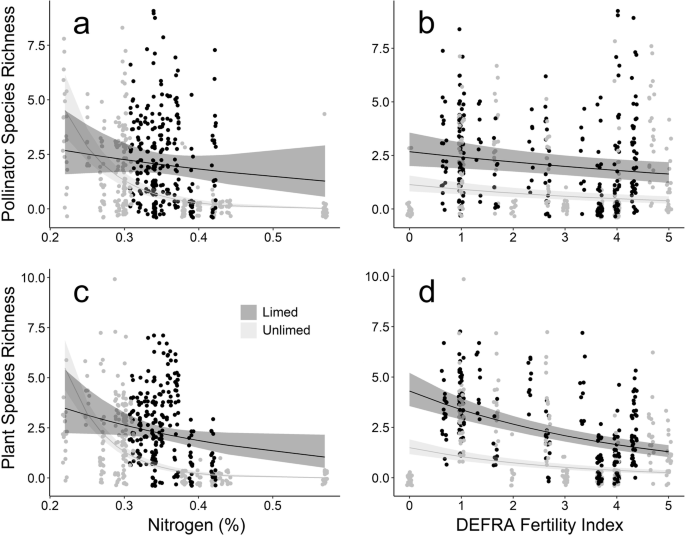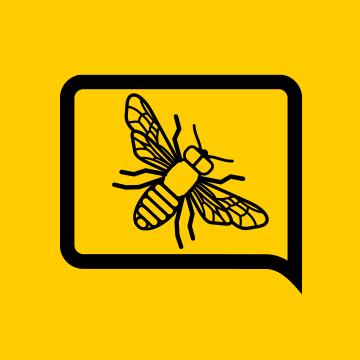g5000
Diamond Member
- Nov 26, 2011
- 131,997
- 75,971
- 2,605
According to the world's longest study (see below), the use of common nitrogen fertilizers used on grasslands cuts the number of bees, a.k.a. pollinators, in half compared to grasslands which do not use fertilizer.
Fertilizers cut flowers ninefold, which results in cutting bees in half.
Almost a quarter of the Earth’s land area is agricultural grassland, contributing to the livelihoods of over 800 million people1. Grassland fertilisation has boosted global food production2 but has come at the cost of environmental degradation and adverse effects on human health and welfare3,4. We now fix more reactive nitrogen every year, via the Haber–Bosch process, than all natural processes on land combined5.
Grasslands are used to raise cattle for meat and milk. They are also used to grow grains.
However...soil eutrophication can lead to air pollution, marine and freshwater eutrophication and biodiversity loss, as well as favouring some invasive species. However, agricultural grasslands can potentially deliver ecosystem services, including pollination, natural pest control, greenhouse gas sequestration, water purification, as well as cultural value.
[snip]
Agricultural grassland is the leading land use category in the UK (46%)7, far exceeding arable land (25%), urbanized areas (~10%), urban gardens, (~2%), or wooded areas (~10%)8. However, only 1–2% of UK grasslands are now considered high-quality species rich habitats9. This is due to the increased management intensity, especially from the middle of the 20th century, including soil fertilisation and seeding with yield-enhancing species, such as ryegrass.
Pollinators are vital to agricultural productivity and maintaining natural ecosystems10,11. However, declines in the abundance and distribution of many pollinator species have prompted concerns for their pollination services12. While several causes have been identified, agricultural intensification is considered a key factor12,13,14. Despite this, the effects of artificial soil enrichment on pollinators remain poorly understood15.
[snip]
The Park Grass Experiment at Rothamsted, southeast England, was set up in 1856 and is the world’s longest-running ecological experiment2.

 www.nature.com
www.nature.com
Fertilizers cut flowers ninefold, which results in cutting bees in half.
Almost a quarter of the Earth’s land area is agricultural grassland, contributing to the livelihoods of over 800 million people1. Grassland fertilisation has boosted global food production2 but has come at the cost of environmental degradation and adverse effects on human health and welfare3,4. We now fix more reactive nitrogen every year, via the Haber–Bosch process, than all natural processes on land combined5.
Grasslands are used to raise cattle for meat and milk. They are also used to grow grains.
However...soil eutrophication can lead to air pollution, marine and freshwater eutrophication and biodiversity loss, as well as favouring some invasive species. However, agricultural grasslands can potentially deliver ecosystem services, including pollination, natural pest control, greenhouse gas sequestration, water purification, as well as cultural value.
[snip]
Agricultural grassland is the leading land use category in the UK (46%)7, far exceeding arable land (25%), urbanized areas (~10%), urban gardens, (~2%), or wooded areas (~10%)8. However, only 1–2% of UK grasslands are now considered high-quality species rich habitats9. This is due to the increased management intensity, especially from the middle of the 20th century, including soil fertilisation and seeding with yield-enhancing species, such as ryegrass.
Pollinators are vital to agricultural productivity and maintaining natural ecosystems10,11. However, declines in the abundance and distribution of many pollinator species have prompted concerns for their pollination services12. While several causes have been identified, agricultural intensification is considered a key factor12,13,14. Despite this, the effects of artificial soil enrichment on pollinators remain poorly understood15.
[snip]
The Park Grass Experiment at Rothamsted, southeast England, was set up in 1856 and is the world’s longest-running ecological experiment2.

Trade-off between pollinator-wildflower diversity & grassland yields - npj Biodiversity
This is a critical moment for land use policy globally, with many countries (e.g. the UK and the European Union) currently undertaking significant green reforms of their agricultural policies. Despite their importance for maintaining agricultural outputs and plant diversity, the effects of...

